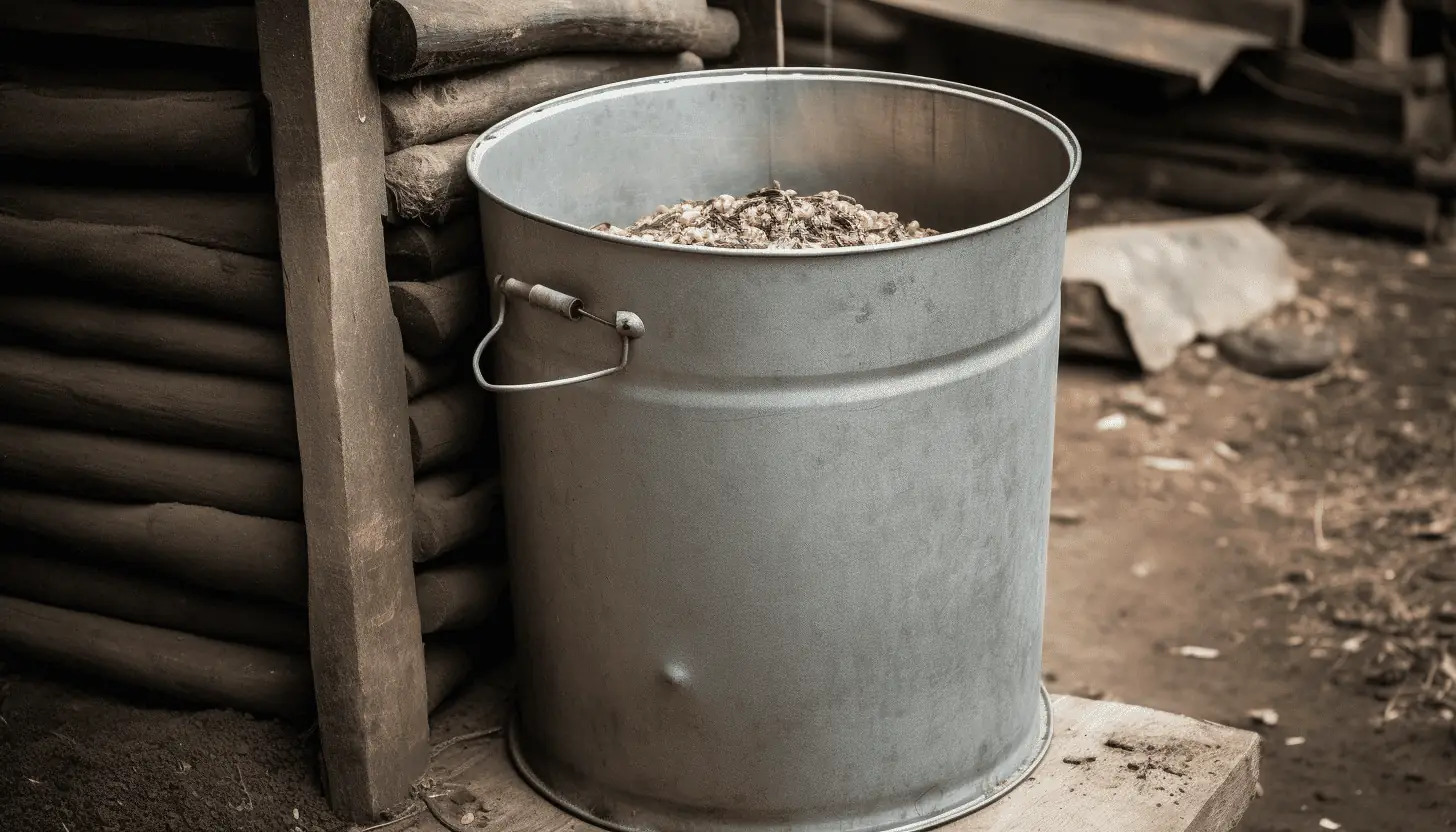If you’ve ever stared at the bags of commercial chicken feed at your local farm supply or feed store, and thought, “There’s got to be a better way,” then you’ve come to the right place.
Making your own chicken feed can be a fun, rewarding, and cost-effective way to ensure your feathery friends get the nutrition they need while allowing you to have more control over what goes into their diet.
In this comprehensive guide, we’ll delve into the details of homemade chicken feed, starting with the basic components like grains, proteins, vitamins, and minerals.
We’ll then whip up some nutrient-rich recipes for layer feed, broiler feed, multi-purpose feed, and growing chick feed. And, of course, I’ll help you customize these recipes to suit your flock’s specific needs.
We’ll also explore the cost and feasibility of making your own chicken feed, comparing it to commercial options and offering tips for sourcing affordable ingredients.
So, grab your mixing bucket and measuring cups, and let’s get started.
Table of Contents
Basic Components of Chicken Feed
Before we dive into the recipes, let’s first take a moment to understand the key components of feeding chickens. Here’s what you need to know about the building blocks of mixing your own chicken feed.
Grains: Types and proportions
Grains are the backbone of all chicken feed, providing essential carbohydrates and energy for your birds.
Typically, you’ll want to aim for a mix that is about 60-70% grains.
The most commonly used grains in chicken feed are corn and wheat, with corn providing more energy and wheat offering a more balanced nutritional profile.
A combination of both is often recommended, as it provides a good balance of nutrients and helps maintain a healthy digestive system.
Other grains you can consider include barley, oats, and rye. Keep in mind that each grain has its own unique nutritional content, so it’s essential to strike the right balance for your flock’s specific needs.
Protein sources: Legumes, fish meal, and alternatives
Protein is vital for maintaining your chickens’ health and ensuring proper growth and egg production. Depending on your flock’s life stage, you’ll need to provide 16-24% protein in their diet.
Commonly used industrial protein sources include soybean meal, which boasts a high protein content of around 45%, and fish meal, offering around 60% protein.
Another option for protein is meat, which can be obtained from food scraps. Chickens are omnivores and can consume meat as a source of protein. However, be cautious about the quality and freshness of the scraps to avoid any potential health issues.
If you’re looking to avoid soy or animal products, alternatives include canola meal, hemp seeds, and sunflower meal. Be aware that the protein content may vary, so adjust the proportions accordingly to meet your chickens’ nutritional needs.
Calcium sources for laying hens
Calcium is a must-have for laying hens, as it’s vital for strong eggshells. A laying hen’s diet should contain around 3.5-4.5% calcium.
One of the most common calcium source is limestone or oyster shell, which can be purchased in crushed form and added to your feed.
Alternatively, you can provide a separate container of crushed oyster shells or limestone for your hens to peck at as needed. This allows them to self-regulate their calcium intake, ensuring they get just the right amount for their egg-laying needs.
Grit: An essential addition for healthy digestion
Chickens also require grit to help them properly digest their food. Grit is essentially small rocks or bits of hard materials, like crushed shells, that chickens swallow, which then reside in their gizzard.
As the gizzard contracts, the grit grinds up the food, aiding in digestion. While free-ranging chickens can often find enough grit on their own, it’s important to provide a source of grit for chickens that don’t have access to natural sources.
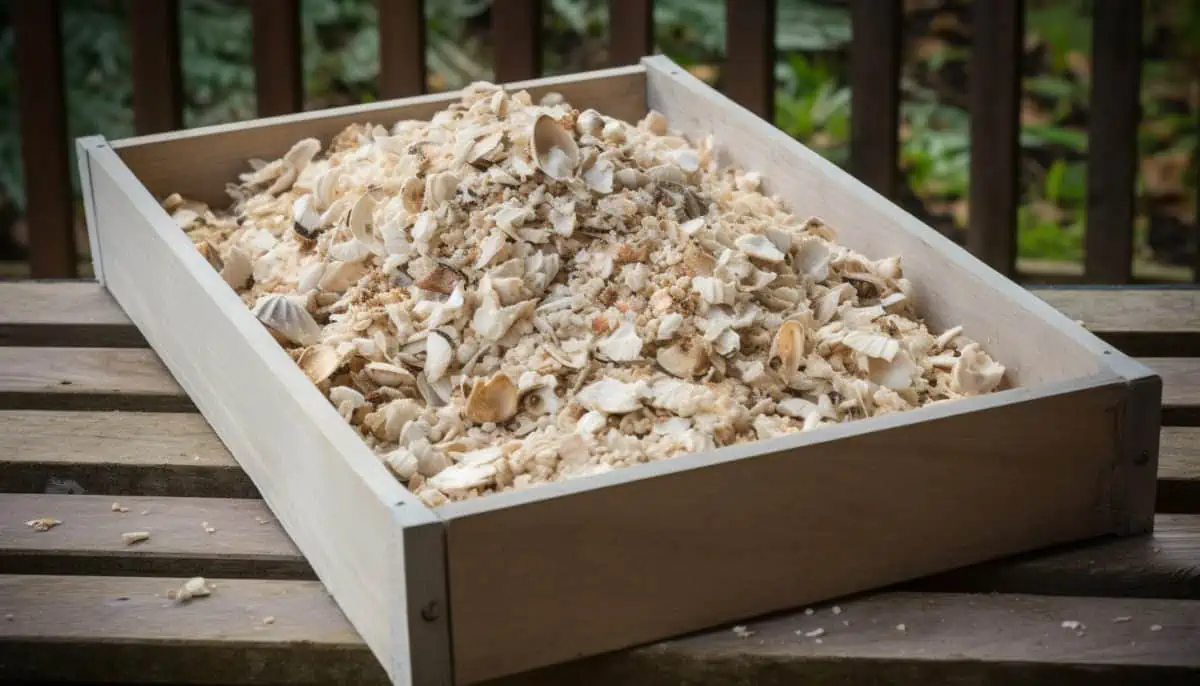
Micronutrients: Natural sources and supplements
Vitamins, minerals, and other micronutrients are crucial for various bodily functions, immune system support, and overall health.
While some of these essential nutrients can be found in grains and protein sources, it’s sometimes necessary to supplement your homemade feed to ensure birds flock get everything they need.
Some natural sources of vitamins and minerals include alfalfa meal, kelp meal, and fish oil.
If you’re looking for more readily available sources, consider adding fruits and vegetables, such as dark leafy greens and squash, to their diet. In addition, commercial vitamin and mineral premixes can be purchased to make sure your chickens get the right balance of nutrients.
Chickens also require specific amino acids, such as methionine and lysine, as well as phosphorus to support their growth and overall health. These can be found in protein sources like legumes, or you can use commercial supplements.
Now that we’ve covered the basics, it’s time to put these components together and create some delicious, nutritious homemade feed recipes for your flock.
Your Easy Homemade Chicken Feed Recipe
In this section, we’ll delve into the practical homemade chicken feed recipes for different types of chickens. The proportions mentioned are based on recommended nutritional recommendations by the University of Georgia combined with personal experience.
Keep in mind that these recipes can be modified according to your flock’s specific needs and the availability of ingredients.
Layer Feed Recipe
Laying hens are all about the eggs, so their diet should focus on calcium for strong shells and a proper balance of protein, carbs, and fat. Aim for 16-18% protein, 3.5-4.5% calcium, and 4% fat. And don’t skimp on the vitamins and minerals – they need those too!
Here’s a concise layer feed recipe:
| Nutrient | Needed | Ingredient | Proportion | Alternative Options |
|---|---|---|---|---|
| Protein | 16-18% | Soybean meal | 35% | Sunflower meal, canola meal, cottonseed meal, fish meal, meat meal, or dried insects (e.g., black soldier fly larvae or mealworms) |
| Carbohydrates | ~65% | Corn | 30% | Barley, millet, or other grains |
| Carbohydrates | ~65% | Wheat | 20% | Barley, millet, or other grains |
| Fat | 4.0% | Vegetable oil | 1-3% | Animal fats, oilseeds (soybean, sunflower) |
| Fiber | 3.0-4.0% | Wheat bran | 5% | Rice bran or other fibrous ingredients |
| Calcium | 3.50-4.50% | Limestone | 3% | Ground oyster shells or crushed eggshells |
| Greens | – | Alfalfa meal | 3% | Clover, dandelion, kale, or spinach |
| Vitamins & Minerals | – | Vitamin & mineral premix | 2% | See natural sources below |
Note that the proportions of ingredients are not equal to the percentage of nutrients needed because the ingredients are not pure sources of a single nutrient.
Most ingredients contain a combination of nutrients, and their composition varies. For example, soybean meal contains approximately 45% protein, 30% carbohydrates, and 20% fat.
To provide the required nutrients, the proportions of ingredients are adjusted accordingly.
Broiler Feed Recipe
These meaty fellows need lots of protein for their plump and juicy goodness. Shoot for 20-24% protein and a little extra fat. Remember to keep calcium levels less than 1%, to prevent kidney issues.
Here’s a no-nonsense broiler feed recipe:
| Nutrient | Needed | Ingredient | Proportion | Alternative Options |
|---|---|---|---|---|
| Protein | 20-24% | Soybean meal | 40% | Sunflower meal, canola meal, cottonseed meal, fish meal, meat meal, or dried insects (e.g., black soldier fly larvae or mealworms) |
| Carbohydrates | ~65% | Corn | 25% | Barley, millet, or other grains |
| Carbohydrates | ~65% | Wheat | 20% | Barley, millet, or other grains |
| Fat | 5.0-6.0% | Vegetable oil | 1-3% | Animal fats, oilseeds (soybean, sunflower) |
| Fiber | 2.5% | Wheat bran | 5% | Rice bran or other fibrous ingredients |
| Calcium | ~.90% | Limestone | 1.5% | Ground oyster shells or crushed eggshells |
| Greens | – | Alfalfa meal | 3% | Clover, dandelion, kale, or spinach |
| Vitamins & Minerals | – | Vitamin & mineral premix | 2% | See natural sources below |
Personally, we appreciate chickens with a layer of extra fat that we render and use for cooking. In this case, you may want to give them more fat than recommended above.
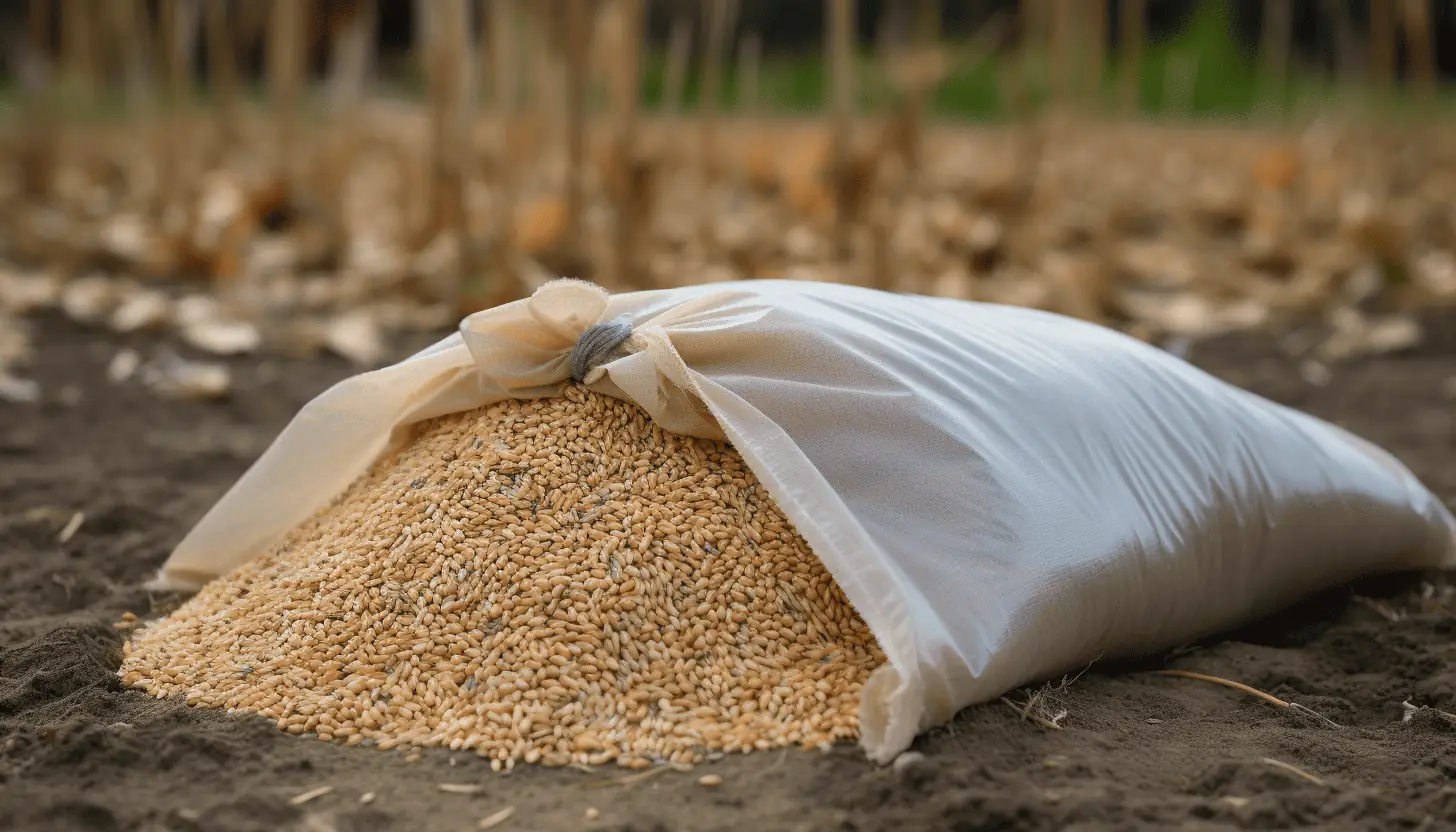
Multi-purpose Hen Feed Recipe
Multi-purpose hens need a well-rounded diet suitable for egg-laying and meat production. Here’s a straightforward multi-purpose hen feed recipe:
| Nutrient | Needed | Ingredient | Proportion | Alternative Options |
|---|---|---|---|---|
| Protein | 17-19% | Soybean meal | 35% | Sunflower meal, canola meal, cottonseed meal, fish meal, meat meal, or dried insects (e.g., black soldier fly larvae or mealworms) |
| Carbohydrates | ~70% | Corn | 30% | Barley, millet, or other grains |
| Carbohydrates | ~70% | Wheat | 20% | Barley, millet, or other grains |
| Fat | 4.0% | Vegetable oil | 1-3% | Animal fats, oilseeds (soybean, sunflower) |
| Fiber | 3.0-4.0% | Wheat bran | 5% | Rice bran or other fibrous ingredients |
| Calcium | 2.50-3.50% | Limestone | 2.5% | Ground oyster shells or crushed eggshells |
| Greens | – | Alfalfa meal | 3% | Clover, dandelion, kale, or spinach |
| Vitamins & Minerals | – | Vitamin & mineral premix | 2% | See natural sources below |
Growing Chick Feed Recipe
Baby chicks grow up so fast! To keep up with their growth, aim for a diet with 20-22% protein, some calcium (~1%) for bone growth, and similar fat and carb ratios as adult chickens.
Don’t forget to crush the grains during the first 6-8 weeks. You can slowly lower the protein content as the chicks age, transitioning them to layer feed when they reach the appropriate life stage.
Here’s a practical growing chick feed recipe:
| Nutrient | Needed | Ingredient | Proportion | Alternative Options |
|---|---|---|---|---|
| Protein | 20-22% | Soybean meal | 40% | Sunflower meal, canola meal, cottonseed meal, fish meal, meat meal, or dried insects (e.g., black soldier fly larvae or mealworms) |
| Carbohydrates | ~70% | Corn | 30% | Barley, millet, or other grains |
| Carbohydrates | ~70% | Wheat | 20% | Barley, millet, or other grains |
| Fat | 4.0% | Vegetable oil | 1-3% | Animal fats, oilseeds (soybean, sunflower) |
| Fiber | 3.0% | Wheat bran | 5% | Rice bran or other fibrous ingredients |
| Calcium | 1.0% | Limestone | 1.5% | Ground oyster shells or crushed eggshells |
| Greens | – | Alfalfa meal | 3% | Clover, dandelion, kale, or spinach |
| Vitamins & Minerals | – | Vitamin & mineral premix | 2% | See natural sources below |
Vitamins and Other Micronutrients for Chickens
In addition to the macronutrients mentioned in the recipes, your homemade chicken feed recipe also requires essential vitamins and minerals to maintain optimal health.
Here are the key micronutrients along with their sources:
Vitamins
- Vitamin A: Carrots, fish liver oil, yellow corn, alfalfa meal, and green leafy vegetables.
- Vitamin D: Fish liver oil and sun exposure.
- Vitamin E: Wheat germ oil, vegetable oils, and sunflower seeds.
- Vitamin K: Dark leafy greens like kale and spinach
- B-complex vitamins: Brewer’s yeast, wheat bran, and rice bran.
Minerals
- Calcium: Limestone, crushed oyster shells, seashells, and eggshells.
- Phosphorus: Meat, fish, peanuts.
- Magnesium: Green leafy vegetables, fish meal, and bone meal.
- Potassium: Green leafy vegetables, potatoes, and bananas.
- Iron: Green leafy vegetables, fish meal, and iron supplements.
- Copper: Green leafy vegetables, fish meal, and copper supplements.
- Zinc: Green leafy vegetables, fish meal, and zinc supplements.
Amino acids
- Methionine: Fish meal, soybean meal, and synthetic supplements.
- Lysine: Fish meal, soybean meal, and synthetic supplements.
Trace Elements
- Manganese: Green leafy vegetables, fish meal, and manganese supplements.
- Selenium: Fish meal, sunflower seeds, and selenium supplements.
- Iodine: Iodized salt, fish meal, and kelp meal.
This may seem overwhelming, put in practice including a variety of ingredients in their diet will generally provide a well-rounded nutritional profile. For backyard chickens with access to free-ranging, they will naturally consume insects, seeds, and plants that contribute to their overall nutrition.
Otherwise, you can supplement your homemade feed mix with some of the ingredients mentioned above to ensure the right balance of vitamins and minerals.
That’s essentially it. You now know what you need to know in order to produce your own basic recipe. Do this and they are going to be just fine.
However, if you feel the urge to optimize and geek out a little bit over feed specifics, feel free to read on. I promise, we will go through some interesting stuff.
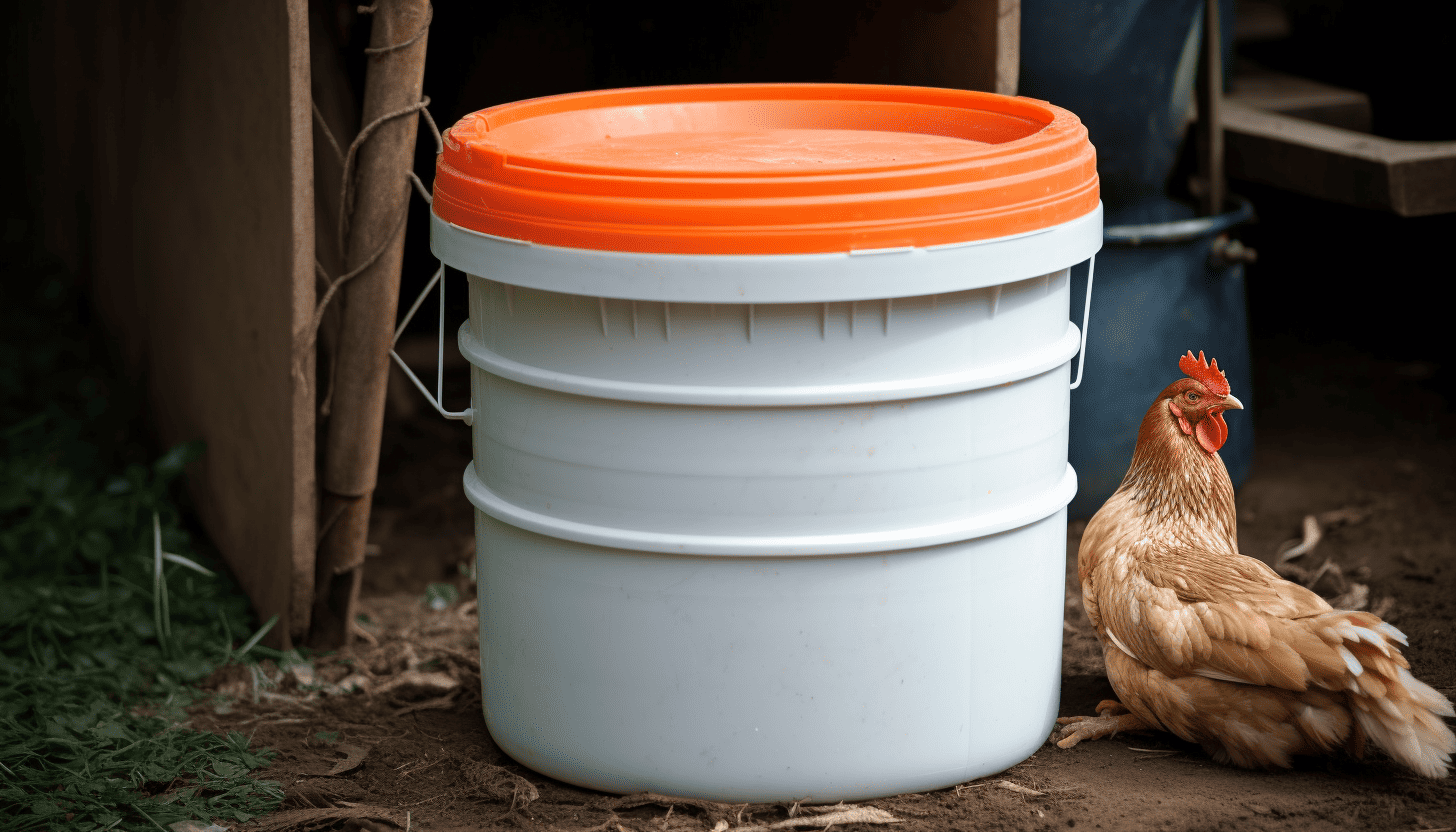
Customizing Feed for Different Chicken Types and Life Stages
Alright, so you’ve got the basics down, but let’s get a little more personal with our feathery friends.
Chickens are unique, just like us, and their nutritional needs vary based on their type and life stage. Let’s dive into those differences and discover how to adjust our feed recipes for layers, broilers, growing chicks, and mixed flocks.
Adjusting Recipes for Specific Needs
Mixed flock: Got a party of layers, broilers, and growing chicks? No problem! To accommodate everyone, aim for a middle ground: about 20% protein (for the chicks to grow), 2.5-3% calcium, and 4% fat. Provide supplemental calcium (like crushed oyster shells) on the side for laying hens, so they can get their eggshells in tip-top shape.
Foraging flock: If your chickens are lucky enough to roam around and forage, they’ll naturally nibble on bugs, plants, and seeds to supplement their diet. You can reduce the protein content in their feed, but keep an eye on their overall health and adjust as needed.
Soy-free feed: Want to avoid soy? No worries! Swap out soybean meal for alternative protein sources like canola meal, hemp seeds, or sunflower seeds. You might have to play with the ratios to find the perfect balance, but your chickens will enjoy the variety.
By understanding the nutritional needs of your chickens and tweaking the recipes to suit their type and life stage, you’ll be the proud caretaker of a happy and healthy flock.
Making Your Own Chicken Feed Pellets
Are you ready to level up your feed game? Let’s talk about making your own chicken feed pellets.
Why use Pellets over Grains or Mash?
Pellets offer a waste reduction solution for our picky chicken friends. When they’re served grains or mash, they might toss aside the bits they don’t like, often leaving behind those important vitamins. With pellets, every bite is packed with all the nutrients they need.
And who knows, maybe you can sell your high-quality organic feed pellets to friends and neighbors to cover the costs of feeding your own chickens.
Equipment Needed
To make your own chicken feed pellets, you’ll need a hammer mill or feed grinder to grind the feed ingredients into a fine powder. This ensures a uniform texture for the pellets. Then you need a pellet mill, which compresses the feed mixture into pellets.
Steps to Make Feed Pellets at Home
Step 1: Mix the ingredients according to your desired recipe, making sure the proportions are accurate for your chicken type and life stage.
Step 2: Grind the feed mixture with a hammer mill or feed grinder until it’s a fine powder. The finer the texture, the better the pellet quality.
Step 3: Load the feed powder into the pellet mill’s hopper, and let the machine do its magic. It’ll compress the mixture into pellets using heat and pressure.
Step 4: Cool the pellets on a wire rack or spread them out on a flat surface. This allows the heat to dissipate, and the pellets to harden.
Step 5: Store your homemade chicken feed pellets in a airtight containers or bags to keep them fresh and dry, and serve them up to your flock with pride.
And there you have it – your very own chicken feed pellets, made with love and loaded with the nutrients your chickens need to thrive and produce.
Cost and Feasibility of Homemade Chicken Feed
As you weigh the benefits of making your own chicken feed, you might be wondering whether the financial side of things adds up. Let’s compare the costs and conveniences of homemade and commercial feed, and discuss tips for sourcing affordable ingredients.
Homemade Feed:
Ingredient costs: Purchasing the raw ingredients will often be cheaper than buying pre-processed feed pellets, especially if you can source them locally or buy in bulk. However, prices may vary depending on your location and the availability of ingredients.
Equipment costs: Making your own feed might require an initial investment in equipment such as a hammer mill, feed grinder, and pellet mill. These costs can be offset over time as you save on feed expenses, or you can feed the mix without making pellets.
Time and labor: Preparing homemade chicken feed requires time and effort, which can be a factor to consider when weighing the overall costs.
Commercial Feed:
Convenience: Commercial feed is pre-formulated, balanced, and ready to use, which saves you time and effort in preparing your own feed.
Consistency: You can expect a consistent nutritional profile, which might be more challenging to achieve with homemade feed, especially for beginners.
Price: Commercial feed prices can vary depending on the brand and quality. In some cases, it might be more affordable if you find a good deal.
Other Considerations
When comparing the costs of homemade and commercial feed, it’s important to also consider factors beyond just the costs:
Quality control: By making your own chicken feed, you know exactly what goes into it, allowing you to customize the mix to your flock’s specific needs and avoid any unwanted additives or fillers.
Customization: DIY chicken feed allows you to tailor the mix to your flock’s specific needs. You can adjust the nutritional profile based on your location, flock composition, etc.
Social end environmental considerations: Sourcing ingredients locally can reduce the environmental impact of transportation and support local farmers. Additionally, using kitchen scraps or garden waste as feed supplements can help reduce waste.
Health benefits: Understanding chicken nutrition and providing a well-balanced diet can lead to healthier chickens, which in turn may result in better egg production, improved meat quality, and reduced susceptibility to diseases.
Tips for Sourcing Affordable Ingredients
To keep the costs of raising chickens low and maximize the benefits of homemade chicken feed, consider the following tips for sourcing affordable ingredients:
Shop local: Check out your local farmers’ markets and co-ops for fresh, locally sourced ingredients. You may find better deals on grains and other feed components than at big-box stores, and you’ll be supporting local businesses in the process.
Get to know local farmers: Connecting with nearby farmers and grain suppliers can lead to discounts on bulk purchases, especially if you’re willing to buy directly from the source.
Explore alternative ingredients: Be open to using alternative ingredients, like sunflower seeds, hemp seeds, or even mealworms, to meet your chickens’ nutritional needs. This can help diversify your feed while keeping costs in check.
Grow Your Own: If you have the space and resources, consider growing some of your own feed components, like corn, wheat, or even fodder for sprouting. This can be both cost-effective and rewarding.
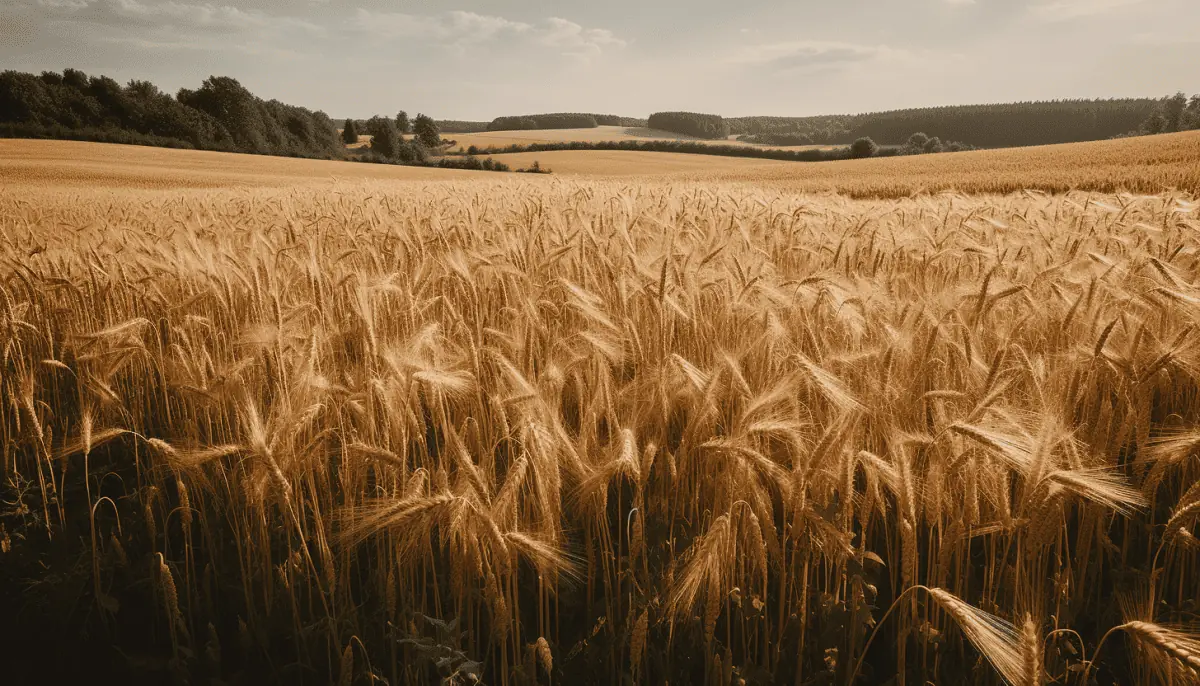
Natural and Alternative Feeding Practices
Now that we’ve covered the nuts and bolts (or should I say, grains and legumes) of making your own chicken feed, let’s explore some natural and alternative feeding practices.
These can help boost your flock’s nutrition, keep your feathered friends entertained, and reduce waste.
Foraging and Free-Ranging
Who doesn’t love freedom, right? Chickens certainly do. Foraging and free-ranging are natural feeding practices that can help diversify your chickens’ diet while keeping them active and entertained.
Free-ranging chickens will snack on insects, worms, plants, and seeds, getting a well-rounded buffet of nutrients in the process.
Keep in mind that foraging alone may not provide all the necessary nutrients for optimal health and productivity, so supplementing with a balanced feed is still recommended.
You can read much more about free-ranging your chickens in this article.
Feeding Kitchen Scraps and Garden Waste
Chickens are basically nature’s recycling machines. They’ll happily munch on kitchen scraps and garden waste, transforming them into tasty eggs and high-quality compost.
Fruits, vegetables, grains, and even crushed eggshells can all find a second life as chicken food.
Just be cautious about giving them moldy or spoiled food, and avoid feeding them salty, sugary, or high-fat fast food scraps, as well as toxic foods like avocado, chocolate, or onions.
Growing Your Own Feed
Got a green thumb? Put it to good use by growing some of your own feed ingredients.
Planting grains, legumes, and other plants like sunflowers, amaranth, or pumpkins can provide your flock with fresh, homegrown nutrition. Plus, you get the satisfaction of knowing exactly where their food is coming from.
Consider growing a “chicken garden” filled with nutritious plants and herbs like clover, alfalfa, and comfrey. You can also grow fodder systems like sprouted grains or microgreens to supplement their diet.
By incorporating natural and alternative feeding practices into your flock’s routine, you’ll be nurturing happy, healthy chickens while reducing waste and embracing a more sustainable lifestyle. Talk about a win-win!
Ensuring Proper Nutrition in Homemade Feed
Alright, you’ve got the recipes, the techniques, and the enthusiasm – but what about making sure your homemade chicken feed is actually providing your flock with the nutrients they need?
Let’s dive into how to balance protein, carbohydrates, fats, vitamins, and minerals, and keep an eye on your flock’s health and well-being.
Balancing Protein, Carbohydrates, Fats, Vitamins, and Minerals
When creating your own chicken feed, it’s essential to balance the nutrients to meet your flock’s requirements. As you know, different chicken types and life stages need varying amounts of protein, carbohydrates, fats, vitamins, and minerals.
Keep a close eye on the ingredients and proportions, and don’t be afraid to make adjustments as needed.
Monitoring the Health and Well-Being of Your Flock
Pay attention to your flock’s behavior, appearance, and egg production. Healthy chickens will be active, have bright eyes, and lay consistently during summer.
If something seems off, it could be a sign to reevaluate their diet.
Signs of Nutritional Deficiencies and How to Address Them
Nutritional deficiencies can manifest in various ways, such as reduced egg production, brittle feathers, or lethargy. If you notice any of these signs, double-check your feed recipe and consider supplementing your with additional vitamins or minerals.
However, serious signs of disease should be addressed by consulting with a veterinarian or poultry expert.
Historical and Traditional Chicken Feeding Practices
Feeling a little nostalgic? Let’s end this article with a quick trip down memory lane and explore how chickens were fed in the past. As with many other things in life, there’s a lot we can learn from historical and traditional practices.
How Chickens Were Fed in the Past
Back in the day, chickens were primarily free-rangers, foraging for insects, worms, and plants in backyards and on farms.
Supplemental feeding often included kitchen scraps, garden waste, and whatever grains were available. It was a simpler time, with less focus on optimum nutrients and more on letting chickens do what they do best – scratch, peck, and cluck.
When asking my dad how they would feed their chickens back in the 40s and 50s, this is exactly that he said: “A bucket of weat, food scraps and lots of beetles, worms, and insects”.
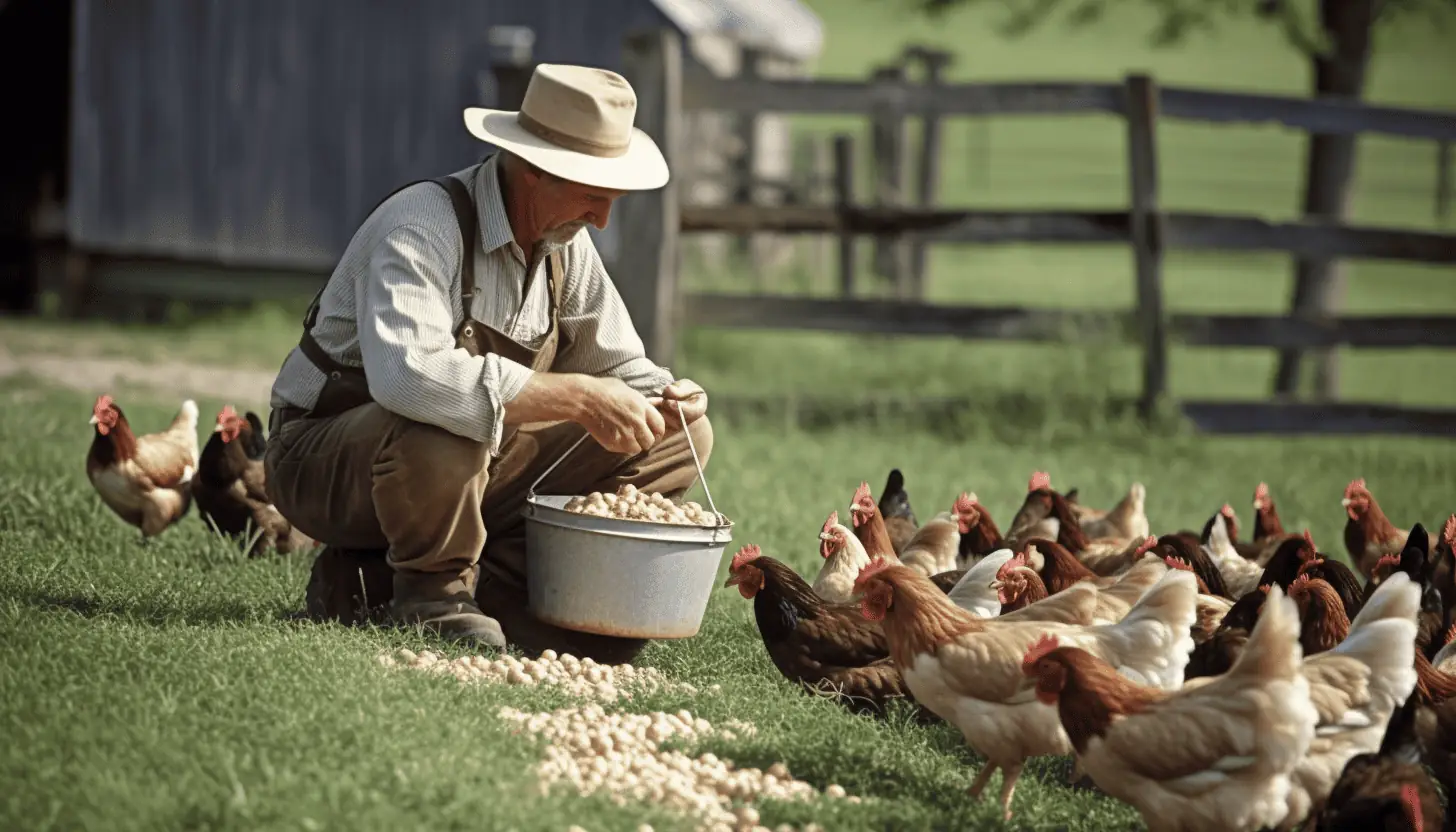
However, back then productivity was lower and chickens didn’t lay as many eggs or grow as fast as they do today.
The focus on nutrition and specialized feeds has contributed to the improvement in productivity we see in modern poultry farming, but optimizing output it not always our main priority.
Lessons from the Amish and Other Self-Sufficient Communities
The Amish, known for their old-timey and self-sufficient lifestyle, provide us with valuable lessons in chicken feeding. They often mix homegrown grains, locally sourced ingredients, and let the chickens free range.
The exact feed composition will vary depending on the region, available resources, and the preferences of each family. Here are some common components of Amish chicken feed:
Homegrown grains: The Amish often grow their own grains, such as corn, wheat, barley, or oats, and use them as the primary source of energy and carbohydrates in their feed.
Protein sources: Most Amish farmers avoid feed ingredients like bone meal and meat. Instead they use homegrown legumes and foraging.
Forage: Amish chickens are typically allowed to free-range or have access to pasture, where they can forage for insects, seeds, plants, and other natural food sources. This helps supplement their diet and provides essential nutrients.
Kitchen and garden scraps: The Amish often feed their chickens kitchen scraps and garden waste, such as vegetable peels, fruit trimmings, and wilted greens. This helps reduce waste and provides additional nutrients to the chickens.
Calcium sources: For laying hens, calcium-rich vegetables and crushed eggshells may be added to the feed to support strong eggshell formation.
Greens: Leafy greens like kale, spinach, or Swiss chard may be grown in the garden specifically for feeding chickens.
While the Amish may not usually use commercial feed pellets, they still pay close attention to the nutritional needs of their flock, making sure their chickens receive a balanced diet to ensure good health, healthy growth, and high egg production.
In Conclusion
There you have it, fellow chicken keeper. As we wrap up our chicken feed adventure, you’ll be in control of the ingredients, ensuring top-notch nutrition for your flock, and potentially saving some cash along the way.
Plus, there’s the satisfaction of knowing you’re taking a hands-on approach to your chickens’ well-being.
By making your own chicken feed, you’ll have the opportunity to customize recipes to fit your flock’s needs, taking into account their specific breed, age, and purpose.
And let’s not forget the fun of experimenting and learning through trial and error.
Don’t be afraid to roll up your sleeves and find the best feed solution for your flock. After all, each chicken is unique, and so are their needs. Embrace your inner poultry Picasso and paint your own chicken feed masterpiece.
Happy feeding, and may your eggs be bountiful.

